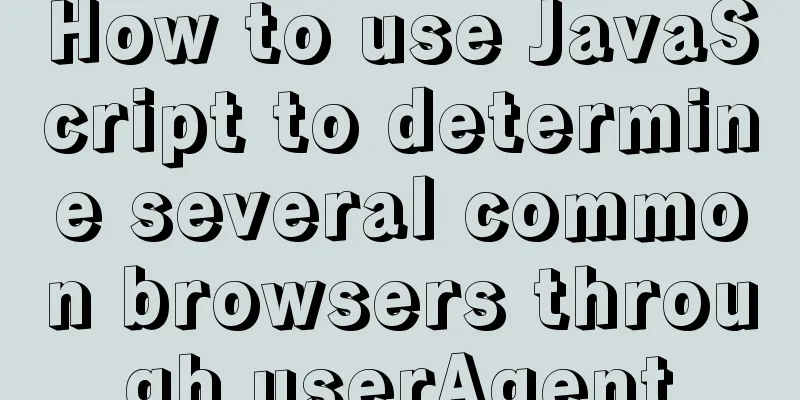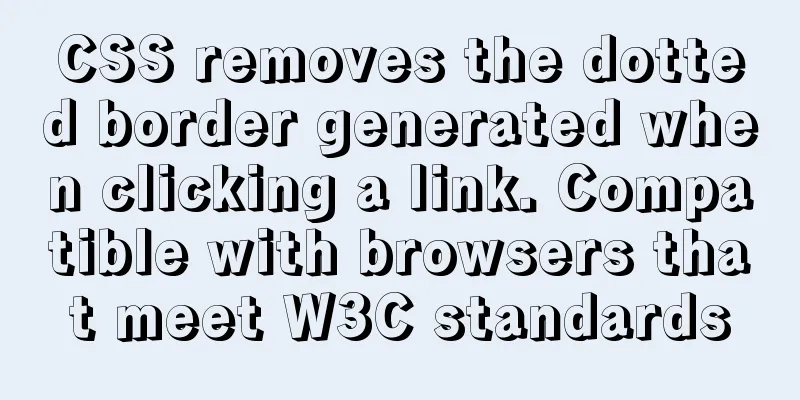A few things you need to know about responsive layout

|
1. Introduction Responsive Web design allows a website to adapt to multiple devices and multiple screens at the same time, allowing the layout and functions of the website to change according to the user's usage environment (screen size, input method, device/browser capabilities). This article mainly introduces some important but easily overlooked knowledge points of responsive layout. If you want to read more high-quality articles, please click on the GitHub blog 2. Viewport The viewport commonly mentioned in mobile front-end is the area in the browser used to present web pages. The viewport is usually not equal to the screen size, especially if the browser window can be resized . There are differences between the viewports on mobile phones and PCs. The viewport width on PCs is equal to the resolution, while the viewport width on mobile devices has nothing to do with the resolution. The default width value is specified by the device manufacturer. iOS and Android basically set the viewport resolution to 980px. 1. Why should the mobile viewport be set to 980px? At that time, Jobs imagined: If the iPhone becomes popular in the market, but various websites have not had time to create mobile-friendly web pages, then users will have to use their mobile phones to access the computer version of the web pages. How can they make the pages on the large screen readable using a small screen ? Boss Joe wanted to fix a viewport width for mobile phones, making the viewport width of mobile phones equal to the page width of most PC web pages in the world, which is 980px. In this way, when you use your mobile phone to access the computer version of the web page, there is no blank space next to it. However, after the page is zoomed, the text will become very small, and users need to manually zoom in and out to see it clearly, which is a very poor experience.
2. Constrain the viewport To solve the previous problem, you can add the following line of code to the web page: <meta name="viewport" content="width=device-width, initial-scale=1.0, maximum-scale=1.0, user-scalable=0" /> width=device-width The viewport is the device width (a width set by humans) //If not set, the default is 980px initial-scale=1.0 The initial viewport size is 1.0 maximum-scale=1.0 The maximum multiple is 1.0 user-scalable=0 Scaling the viewport is not allowed The viewport tag tells the browser how to render the web page. Here, the tag means: render the web page content according to the device width (device-width). In fact, if you take a look at the effect on a device that supports this tag, you will understand.
Not bad! User experience is greatly improved! ! ! 3. Pictures People often say “a picture is worth a thousand words”, and it’s true. No matter how much text we put on our webpage about muffins, it will not be as attractive as the pictures. Next, we will add a picture of a pancake (2000 pixels wide) at the top of the page, which will have a similar effect to the large title picture that entices users to look down.
Wow, that’s a really big image. It makes the whole page look unbalanced and overflows horizontally. No, this problem must be solved. We can use CSS to give the image a fixed width, but the problem is that we want it to scale automatically on screens of different sizes . For example, the iPhone screen width in our example is 320 pixels. If we set the image to 320 pixels wide, what happens when the iPhone screen is rotated? At this time, 320 pixels becomes 480 pixels.
img {
max-width: 100%;
} Going back to the phone and refreshing the page, the result is more in line with expectations. Why not use width:100%? To achieve automatic scaling of images, you can also use the more general width attribute, such as width:100%. However, this rule does not apply here. Because this rule will cause it to appear as wide as its container. In cases where the container is much wider than the image, the image will be stretched unnecessarily. 4. Mobile browser kernel On the mobile side, there are only four independent browser kernels, namely Microsoft's Trident, Firefox's Gecko, the open source kernel Webkit, and Opera's Presto. Compatible prefixes: 1-ms- 2 -moz- 3 -o- 4 -webkit- Browser market share of Chinese users:
UC, Android built-in, Chrome, Safari, and QQ Browser are all based on webkit kernels, and as can be seen from the figure, they account for the vast majority of the market share. 5. Flow layout Percentage layout is also called flow layout and flexible box layout. The mobile web page has no center page, it is filled up on both sides.
Let's look at an example:
div{
width:200px;
height:300px;
padding:10px;
}
div p{
width:50%;
height:50%;
padding:10%;
}
What is the actual width of p at this time?
At this time, the actual width of p is 140px*190px VI. Media Inquiries 1. Why does responsive web design need media queries? CSS3 media queries allow us to apply specific CSS styles to web pages based on specific device capabilities or conditions . Without media queries, it would be impossible to significantly modify the appearance of a web page using CSS alone. This module allows us to write CSS rules in advance that adapt to many unpredictable factors, such as horizontal or vertical screen orientation, large or small viewports, and so on. Although flexible layout allows the design to adapt to more scenarios, including screens of certain sizes, it is sometimes not enough because we also need to make more detailed adjustments to the layout. Media queries make this possible, which are the equivalent of basic conditional logic in CSS. 2. Media query syntax The first rule we write outside of the media query is the “base” style that applies to any device. On this basis, we gradually add different visual effects and functions for devices with different viewports and capabilities.
body {
background-color: grey;
}
@media screen and (min-width:1200px) {
body{
background-color: pink;
}
}
@media screen and (min-width:700px) and (max-width:1200px) {
body{
background-color: blue;
}
}
@media screen and (max-width:700px) {
body{
background-color: orange;
}
} @media represents media query, which queries what device is currently viewing this web page and its width. Screen means that the device for viewing this webpage is a monitor, not a hearing device for the disabled or a printer. Use the and symbol to list all the possibilities. 7. Rem responsive layout
rem: The style values of the REM units of the elements in the current page are dynamically calculated based on the font-size value of the HTML element. body →font-size:20px; <div class="box1"> → font-size:2em; box1 <div class="box2"> → font-size:2em; box2 <div class="box3"> → font-size:2em; box3 </div> </div> </div>
When em is used as the unit, the font-size property is calculated and inherited, and box1 is calculated to be 40px. Then box2 and box3 inside inherit 40px. The em unit can not only be used to set font size, but also to set any box model properties, such as width, height, padding, margin, border
@media screen and (min-width: 320px) {
html {font-size: 14px;}
}
@media screen and (min-width: 360px) {
html {font-size: 16px;}
}
@media screen and (min-width: 400px) {
html {font-size: 18px;}
}
If the H5 page we made is only accessed on mobile devices, this is because REM is not compatible with lower versions of browsers. If the mobile and PC terminals share a set of codes, it is recommended to use flow layout.
1. Get the PSD design from the UI designer, and then set a font-size value for HTML in the style. We usually set a value that is convenient for later calculations, for example: 100px
html{
font-size:100px; //1rem=100px
} 2. Write the page and the style <br /> First, write the style according to the size of the design draft. Then, when writing the style value, you need to divide the pixel value by 100 to calculate the corresponding REM value. margin:0 0.2rem height:3rem; 3. Calculate the font-size value of our HTML based on the current screen width and the width of the design draft <br /> For example: the width of the design draft is 640px, and one of the parts is a slideshow, which is 600*300 in size. In the style, set a font-size value of 100px for HTML, then the slideshow size should be 6rem×3rem. If the mobile phone screen width is 375px, how much should its font-size be set to. 375/640*100->fontsize=58.59375//The slideshow can adapt to the size of the mobile phone screen Based on the ratio of the current screen width to the design draft width, dynamically calculate what the fontsize value should be at the current width. If the fontsize value changes, the values of all previously set REM units will automatically increase or decrease accordingly . This can be achieved with the following code:
<script>
~function(){
var desW=640,
winW=document.documentElement.clientwidth,
ratio=winW/desW;
document.documentElement.style.fontSize=ratio*100+"px";
}();
</script>But if the current screen width is larger than the design width, the image will be stretched and distorted, so the above code needs to be slightly modified:
//html part <section id="main">
<div class="box"></div>
</section>
//js part <script>
~function(){
var desW=640,
winW=document.documentElement.clientwidth,
ratio=winW/desW;
var oMain = document.getElementById('main');
if(winW>desW){
oMain.style.width=desW+"px";
oMain.style.margin="0 auto";
return;
}
document.documentElement.style.fontSize=ratio*100+"px";
}();
</script>The above is the full content of this article. I hope it will be helpful for everyone’s study. I also hope that everyone will support 123WORDPRESS.COM. |
<<: Page Speed Optimization at a Glance
>>: Is a design that complies with design specifications a good design?
Recommend
Antdesign-vue combined with sortablejs to achieve the function of dragging and sorting two tables
Table of contents Achieve results Introduction to...
jQuery implements ad display and hide animation
We often see ads appear after a few seconds and t...
Steps to modify the MySQL database data file path under Linux
After installing the MySQL database using the rpm...
js dynamically adds example code for a list of circled numbers
1. Add the ul tag in the body first <!-- Unord...
Detailed explanation of how to use relative paths in HTML to obtain files at all levels of directories
The concept of relative path Use the current file...
Sample code for changing the color of a png image through a CSS3 filter
This method uses the drop-shadow filter in CSS3 t...
CSS Tricks to Create Wave Effects
It has always been very difficult to achieve wave...
Tips for making web table frames
<br />Tips for making web table frames. ----...
Analysis and solution of flex layout collapse caused by Chrome 73
Phenomenon There are several nested flex structur...
Analysis of MySQL Aborted connection warning log
Preface: Sometimes, the session connected to MySQ...
Analysis and summary of the impact of MySQL transactions on efficiency
1. Database transactions will reduce database per...
Tutorial on building a zookeeper server on Windows
Installation & Configuration The official web...
Linux disk space release problem summary
The /partition utilization of a server in IDC is ...
Detailed explanation of the process of installing msf on Linux system
Or write down the installation process yourself! ...
Ubuntu 16.04 mysql5.7.17 open remote port 3306
Enable remote access to MySQL By default, MySQL u...















